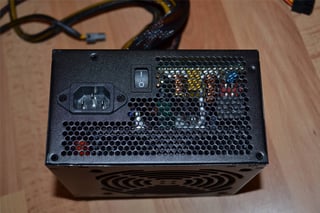I had an old PC (the build was originally a Siemens Celsius 460 workstation) whose case I wanted to strip apart and supply with newer components. For most components (those with standardised sizes, i.e. hard drive, optical drive, mainboard) this was easy but I ran into an unexpected problem when wanting to install the new power supply unit.
The previously installed unit — an Astec AA21720 — was screwed into a metal in-between casing thing[1] and then onto the back of the case. The new unit — a Corsair VS350 — has its screwholes in different locations (what I presume is today’s standard locations). It’s not physically possible to fasten the new PSU with the screws and the in-between thing-a-ma-jig[1] provided and it’s not really possible to screw it in without it. But, the new PSU, while being wider than the old one (15 cm versus 12.5 cm) is still slimmer than the width of the case (approx. 18 cm). This leads me to believe that I haven’t lost yet. But let me show you some pictures first, so we know what we are talking about:

The old PSU with the thing-a-ma-jig[1] to screw into the back of the chassis.

The new PSU as is. But with the screw locations visible.

And these are both to compare them with each other.
Are there any positioning-adapter thing-a-ma-jigsies[2] that I could buy and put between the new PSU and the back side of the case, so that all screws can fit into holes made for them? Sort of like the thing-a-ma-jig[1] the old PSU has, which basically allows to screw that one into chassis screw holes which are somewhere completely different. (If I could, I would buy the lowest-end cheap stuff because I don’t give a damn about most of the cool things that a case can do, so assume the bottom end of the price scale for standard PC cases.)
For convenience, I have labelled the two things I don’t know what to call by superscripted [1] and [2]. Superscripted [1] always refers to the metal thing seen in the first picture, distinguishable from the PSU by its darker shade of grey. Superscripted [2] refers to some similar thing I do not own yet.